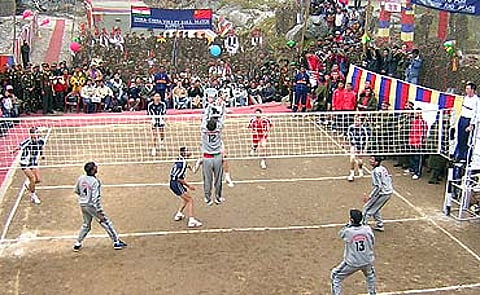Yunnan, End Of The Sulk Route
The first-ever India-China army exercise is coming up. Bury '62?
The first joint Sino-Indian military exercise will he held during December 19-28 in China. Here is what it means:
- Special emphasis on counter-terrorist operations
- The Indian and Chinese contingents will work as a single unit
- It will be the first step towards relaxing tensions between the two armies
- It will expose India to Chinese military tactics and doctrine
- Foreign policy experts welcome the joint exercise but feel it will have little impact on the border dispute
***

According to army sources, meticulous planning has gone into formulating the exercise. Every detail and strategic nuance has been factored in. After all, Sino-Indian relations, ever since the 1962 Chinese invasion, have been full of complexities and marked by suspicion on both sides. So, on May 29, 2006, when Union defence minister Pranab Mukherjee inked an MOU with his Chinese counterpart General Cao Gangchuan, it was the first such agreement between the two Asian powers.
Both sides then agreed to hold an annual defence dialogue, besides frequent meetings between senior military officials and joint military training and exercises. It also laid down a mechanism for an exchange programme for military officers and bureaucrats. This was intended to facilitate study tours, seminars, as well as stints at military training academies in both countries. So far, the Indian and Chinese navies have conducted joint exercises, gauging each other's strengths in the strategic Malacca Straits that serves as a major channel for oil supplies to Southeast Asia and Japan.
The finer details of the first army exercise are currently being worked out. A Chinese delegation is expected soon in Calcutta to finalise plans. A meeting is scheduled at Fort William, home to the headquarters of the army's Eastern Command which also guards India's borders with China. The December 19-28 army exercise will broadly focus on counter-terrorism, defence ministry sources told Outlook. The two sides will conduct joint operations at the company and battalion level and work together as a single unit in mock counter-insurgency situations. They will share weapons, rations, logistics, tactics, operational concepts, battle procedures and try and evolve joint doctrines. Sources say they could also look at evolving joint anti-hijacking operations.
This, however, is not the first instance of a cooperative effort between the Indian Army and the People's Liberation Army (PLA). In 2004, after a visit by then defence minister George Fernandes, an Indian army-PLA team scaled a peak in the Himalayas. While that was only a joint mountaineering expedition, what was interesting was that the peak climbed was in Chinese-occupied Ladakh, which India lost in the 1962 war.
China-watchers say the joint exercise will provide an opportunity for the Indians and the Chinese to trade skills and information. Says Brigadier Arun Sahgal (retd), currently heading the research division of the United Services Institution in Delhi: "The exercise will offer us an excellent opportunity to observe the Chinese at close quarters and see how they operate. We can also gauge each other's strengths." Sahgal, a long-time China-watcher, feels the joint exercise will at least be a first step in relaxing tensions between the two armies.
The whole thing fell into place only after some drama and diplomatic wrangling, though. Sources told Outlook that while the Chinese were keen the delegation to set the ball rolling should be led by the defence secretary, India insisted a joint secretary would be adequate. This created a minor hiccup, as the Chinese don't have any official of similar rank within their military bureaucracy. So while Bimal Julka, a joint secretary in the defence ministry, was chosen to head the Indian delegation, a PLA major general led the China. This was a potential protocol issue because a PLA major general is considered a one-star general, while a joint secretary in India is equivalent to a lieutenant general, a higher rank. That said, the two sides managed to get over this subtle game of oneupmanship and held the first of their meetings two months ago—leading up to Kunming.
But will the exercise make any significant impact on bilateral relations, which are at best strained even today? Most experts believe it will not reduce tension between the two countries. Lieutenant general Vijay Oberoi, who has served as the director general of military operations as well as the vice-chief, says these exercises, though welcome, will have no impact on the ongoing parleys on contentious border issues. "My personal view is that while the military prefers a more robust response, our foreign ministry position has been muted and timid."
On the domestic political front, the joint exercise with the Chinese comes in handy for the government to offset criticism from parties like the CPI(M) on its growing military ties with the US. But not everyone is convinced straightaway by this line of argument. Says a senior CPI(M) leader: "Within the party we think this is more of a smokescreen by the present government to ensure there is little focus on the growing strategic ties with the US."
Meanwhile, there are those who caution the government not to lower the guard along the Sino-Indian border. They feel that the possibility of a short border conflict with the Chinese cannot be ruled out. Says former vice chief Lt Gen Shantonu Chowdhury (retd): "The exercise is a good step, but it will not lead to any settlement of the border issue. We must be alert to the possibility of a clash because that is a real possibility."
Perhaps what Sun Tzu, the Chinese military strategist, said in 6 BC holds true even today: "If you know both yourself and your enemy, you will come out of hundreds of battles without danger." As the iaf plane with army contingent lands in Kunming, India could do well to learn a bit more about its old enemy.
Tags